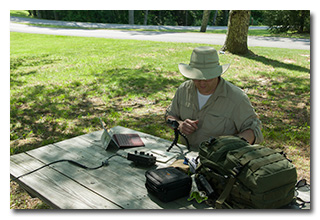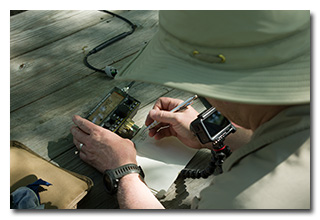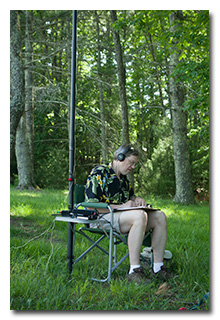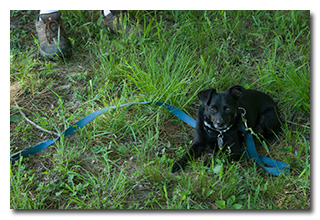
by William Eric McFadden
The Roaring Waters of West Virginia RATpedition!
From the state park's website:
-
With 562-acres, Little Beaver State Park offers family fun, beautiful scenery and incredible outdoor recreation. The park features nearly 20 miles of trails to explore and an 18-acre lake where anglers may fish year-round. Stand up paddle board, kayak, canoe and paddleboat rentals are available seasonally. Park visitors can also enjoy biking, picnicking and camping at Little Beaver.
Pictures
- The Little Beaver State Park sign
- Eric operating; photo by Miles McFadden
- Little Theo at Eric's feet; photo by Miles McFadden
- Thomas operating: 1 | 2; photos by Miles McFadden
Description
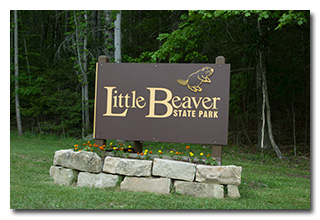 On Saturday, May 21, 2022, three members of the Southeast Ohio Radio Adventure Team
performed successful activations of Little Beaver State Park in West Virginia as part of the Parks on the
Air (POTA; link) program.
On Saturday, May 21, 2022, three members of the Southeast Ohio Radio Adventure Team
performed successful activations of Little Beaver State Park in West Virginia as part of the Parks on the
Air (POTA; link) program.
Instead of visiting southwestern Ohio for Hamvention, Eric McFadden, WD8RIF; Miles McFadden, KD8KNC; and Thomas Witherspoon, K4SWL, traveled from their homes in southeastern Ohio and western North Carolina to meet in West Virginia for The Roaring Waters of West Virginia RATpedition! which was to include three nights of tent-camping and four days of exploration and POTA activations. They were joined by Eric's small dog, Theo.
Following an afternoon spent exploring and activating New River Gorge National Park (link), the trio (plus Theo-dog) arrived at Little Beaver State Park about 2015 UTC. A few minutes of exploration led them to a shaded grassy area near the state park's camping area, adjacent to park of the disc-golf course.
Thomas chose to take advantage of the available picnic table, hanging an end-fed wire antenna in a tree and placing his Elecraft KX2 on the picnic table.
Eric found a shady location at a distance from Thomas, strapped his 31' Jackite telescoping fiberglass mast to his folding camp-chair to support his 28½' wire vertical, and placed his Elecraft KX3 on the camp-chair's fold-up table.
Thomas and Eric both had good cell-signal and were able to use to POTA Spots (link) to spot themselves and to look for park-to-park (P2P) QSO opportunities.
Eric began his operations by using POTA Spots to identify P2P QSO opportunities and at 2031 UTC he completed a P2P QSO on 20m with N9MM who was activating a park in Michigan. (Eric transcribed the park designator wrong; when he looked up the park, it showed to be in Massachusetts.)
Finding himself a frequency to run on 30m while Thomas ran on 20m, Eric's first QSO on 30m came at 2035 UTC with K1EEB in Maine. QSOs came steadily, with Eric's twelfth QSO on 30m coming at 2050 UTC with WA2JMG in New York. This run included a P2P QSO with Thomas and QSOs with operators located in Maine, New Hampshire (2), Vermont, Georgia, Connecticut, Wisconsin, West Virginia, Florida, Quebec, and New York (2).
Pausing to check POTA Spots, at 2053 UTC Eric made a second P2P QSO with Thomas, this time on 20m.
Switching to 40m, Eric's first QSO there came at 2056 UTC with KG2DIG in Kentucky. As on 30m, QSOs came steadily, with Eric's ninth QSO in this run coming at 2105 UTC with AC3IU in Pennsylvania. This run included QSOs with operators located in Kentucky, Tennessee, Ohio, Pennsylvania (3), New York, Minnesota, and Virginia.
Finally, pausing again to check POTA Spots, at 2109 UTC Eric completed a P2P QSO on 20m with WC1N who was activating Manuel F. Correllus State Forest (K-4696) on the island of Martha's Vineyard in Massachusetts.
In all Eric made twenty-four QSOs, including four P2P QSOs. All of Eric's QSOs were CW and were made with five watts output.
Eric would also submit his log to the World Wide Flora and Fauna in Amateur Radio (WWFF; link) program.
Thomas's report will be available soon on his blog, QRPer.com.
Miles did not operate but he helped with set-up and tear-down, he did much of the activation photography, and he kept an eye on little Theo-dog.
As at the previous activations during this RATpedition, Thomas and Eric found that interference between their stations was minimized by operating on bands not harmonically related and by trying to establish distance between the stations.
(return)
